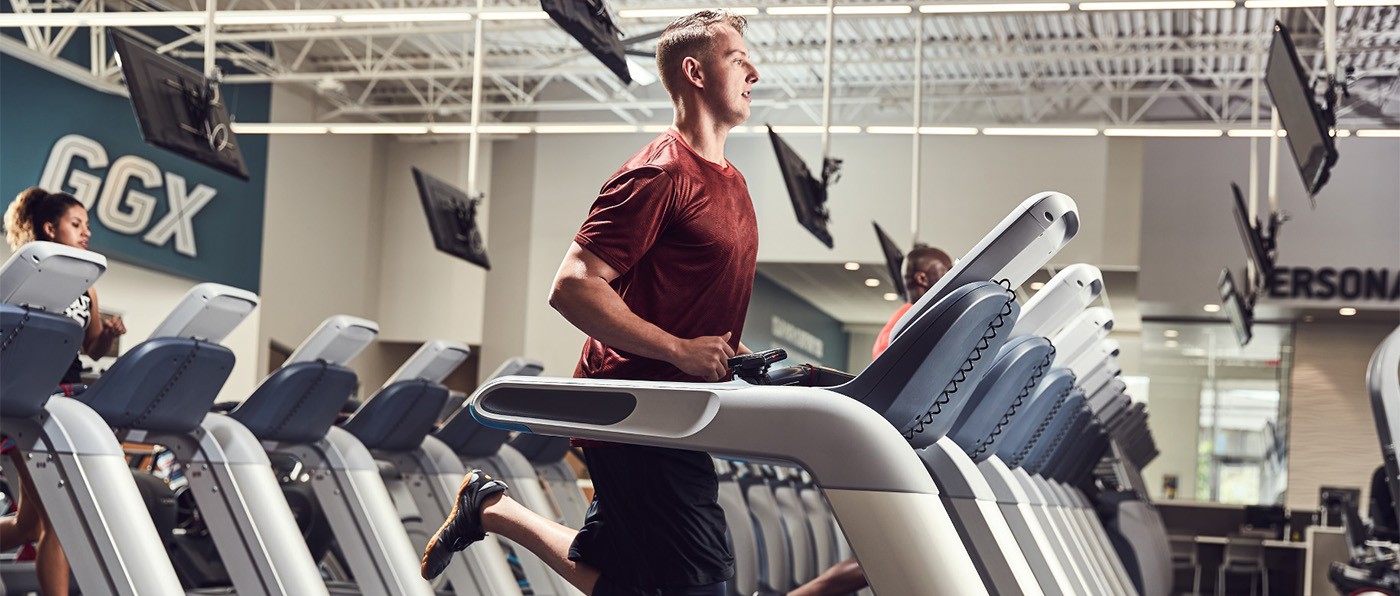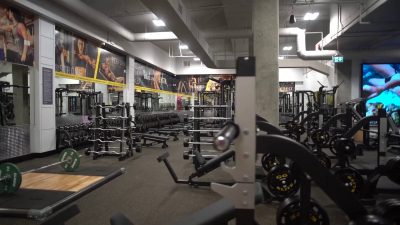Cardio can be confusing. Because of the popularity of high intensity interval training (HIIT), some people may think that traditional cardio is a waste of time. They are wrong. Whether it’s in bursts like HIIT or a continuous steady state, cardio not only increases your heart strength and the capacity of your circulatory system and lungs, but also reduces your risk of developing heart disease or diabetes.
Still, it can be mystifying to figure out which kind of cardio is right for you. So we asked two Gold’s Gym fitness experts to get different perspectives on what cardio to do and when, based on what your goal might be.
Best cardio for weight loss
Jackie Vick, Gold’s Gym Fitness Expert and GOLD’S AMP™ Coach:
Add HIIT training into your regimen. One of the main benefits is EPOC, or excess post-exercise oxygen consumption, where your body continues burning calories even after your workout because it’s working to return to its normal metabolic function. It will take longer to get back to your resting heart rate. It could go on for one or two hours. You’ll be watching a movie, but your body is still burning calories!
Andy Coggan, Gold’s Gym Fitness Expert:
Cardio is just one element of a successful weight-loss journey, along with resistance training, healthy eating, movement quality and rest/recovery. I recommend at least three cardio sessions per week, for a minimum of 30 minutes each. The key is to find an approach that is sustainable and enjoyable, because if you find a cardio activity that you love doing, you’ll be more inclined to keep doing it. The most effective cardio is anything that’s enjoyable and gets your heart rate up and keeps it up for a sustained period of time. For weight loss, we’re really looking at burning calories, so you can go long and slow or fast and intense to burn additional calories to move closer to your goals.
Best cardio to complement strength training
Vick:
If your goal is to add mass, do cardio but keep it steady. Try an inclined walk or stairs. Or try some steady-state (traditional) aerobic training. Just do the treadmill, the stair climber or elliptical to maintain. It’s going to be great for your heart health and blood pressure. You need weights to build your muscles, but you need cardio for your heart health. Heart health means reducing risk of Type 2 diabetes and cardiovascular disease. Cardio lowers blood pressure, lessens the chance of heart attacks and keeps arteries from clogging. Cardio is for the long term.
Coggan:
Although cardio training isn’t typically associated with this goal, it can greatly benefit a person looking to increase strength. Cardio training improves the body’s ability to deliver blood to working muscles, which can directly benefit a person who’s training for strength. It can increase the volume of work they are able to accomplish in a given workout time period and improve the quality and efficiency of muscle recovery. I have worked with many strength athletes who saw long-term performance improvements return after a lull once they focused on improving overall cardiovascular fitness. They all reported generally feeling much better as well.
Best cardio for heart health
Vick:
Frequently, people with this goal have high blood pressure or cardiac disease, or they have had a heart attack. Your resting heart rate should be between 50 and 80 beats per minute. If it’s 90 or 100 or 110, you want to get that checked. So talk to your doctor first. Walking is going to be the easiest form of cardio. Think about walking a certain number of steps every day. See how you feel. Monitor your heart rate. Take a 15- or 20-minute walk. Progress into an elliptical or a stationary bike. After a month, start progressing and adding an extra day and checking your heart rate. A healthy adult should walk five days a week for 30 minutes each day.
Coggan:
To train the heart and lungs, you want to give them a sustained workout using heart rate zones that are between 50 and 80 percent of your max heart rate. It is also important to vary the type and intensity of the workout to get the most benefit. You might have a couple of lighter recovery days in the 50–60 percent zone (light walks with your dog or a friend), a day in the 60–70 percent zone where you go at a greater pace for 30–60 minutes (light jog), and then a couple of days in the 70–80 percent zone where you train at a tough steady-state pace that challenges you for 20–30 minutes (challenging run or jog). HIIT done above 80 percent of max heart rate can be used one to two times per week, as well once a person has built up the cardiovascular health to handle this type of challenge.
Best cardio for overcoming a plateau
Vick:
First, evaluate your situation. Are you dedicated? Are you doing the same forms? If you’re doing steady-state exercise, I would try something else like HIIT. Every four weeks, change up one or two things. If you do interval training two days a week, you could add a day. But I wouldn’t do more than two or three days of HIIT training. If you’re already there, try switching to a steady-state workout. You have to keep changing things.
Coggan:
Any kind of cardio can help bust through plateaus. It can help a strength athlete recover better. It can help a stressed-out executive find release. It can help an athlete improve their muscular endurance and stamina. Bottom line: Cardio is not just for the amateur exerciser. It can help anyone improve what they’re doing when programmed effectively by a fitness professional.
Best cardio for emotional well-being
Vick:
Most of the time, wanting to feel good and improve emotional health are real reasons people come into the gym. Maybe they need a support system or some kind of accountability. It could be a trainer or a workout buddy. Sometimes it’s hard if you don’t know where and how to build those relationships. It can be intimidating to go into a group class. But if you surround yourself with positive people, your emotional health will go toward the positive. If you don’t know where to start, try the GOLD’S AMP™ app. You’ll get inspiration from the trainers and motivation without the intimidation of talking to people. Start with low-intensity workouts, and get yourself feeling good.
Coggan:
Although this question depends highly on the individual, it is very common for people to see cardio training become a form of stress relief or meditation once they have achieved a baseline of fitness and enjoy what they are doing. Once again, the key is finding the right activity that allows you to just enjoy the release it brings and not think so much about what you’re doing. Music is a great way to facilitate this feeling through exercise. A great workout will also release dopamine in the pleasure centers of the brain, giving you a very real reward.
Read more Gold’s Gym stories:
Learning Self-Love at Gold’s Gym
How Exercise Tamed Her Anxiety
What to Expect in Your Next Group Exercise Classes


 WEST BROADWAY
WEST BROADWAY UNIVERSITY MARKETPLACE
UNIVERSITY MARKETPLACE COQUITLAM
COQUITLAM LANGLEY
LANGLEY